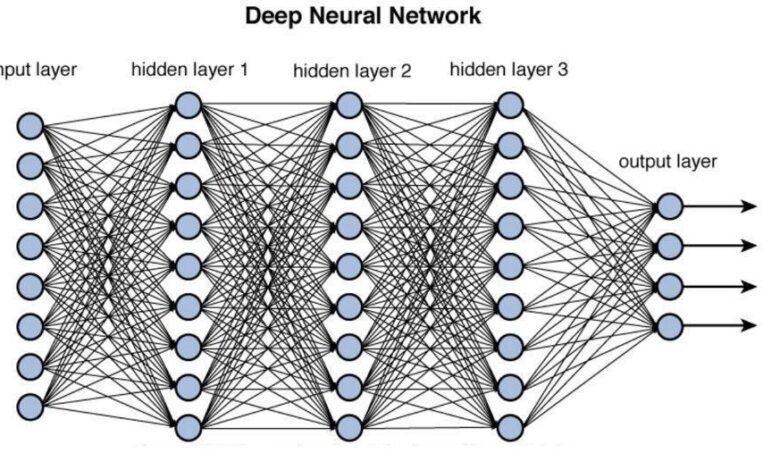Deep Learning Neural Networks Explained: Best Guide of the Technology

Neural Networks Explained in the ever-evolving realm of artificial intelligence, deep learning neural networks stand as a transformative technology, driving advancements in diverse fields from natural language processing to autonomous driving. These sophisticated algorithms mimic the workings of the human brain, enabling machines to learn from data, recognize patterns, and make informed decisions.
The Fundamentals of Neural Networks
At the core of deep learning are neural networks, which consist of layers of interconnected nodes or “neurons.” Each neuron processes input data and transmits the result to the next layer. The essential components include:
Neurons and Layers
Input Layer: Receives the initial data.
Hidden Layers: Perform computations and feature extraction.
Output Layer: Produces the final result.
Weights and Biases
Neurons are characterized by weights and biases, which are adjusted during training to minimize the error in predictions. This adjustment process is crucial for the network to learn and improve its accuracy.
How Deep Learning Neural Networks Work

Training the Network
Training a neural network involves feeding it a large dataset and using an algorithm called backpropagation to fine-tune the weights and biases. This iterative process reduces the error between the predicted output and the actual output.
Activation Functions
Activation functions introduce non-linearity into the model, allowing it to learn complex patterns. Common activation functions include:
ReLU (Rectified Linear Unit): Effective for most tasks due to its simplicity and performance.
Sigmoid: Used in binary classification tasks.
Tanh: Normalizes the output between -1 and 1, often used in hidden layers.
Types of Deep Learning Neural Networks

Feedforward Neural Networks (FNNs)
The simplest type is where data flows in one direction from input to output. They are used for straightforward tasks like image and speech recognition.
Convolutional Neural Networks (CNNs)
Primarily used for image processing tasks, CNNs apply convolutional layers to detect spatial hierarchies and patterns in images. Key components include:
Convolutional Layers: Extract features from input data.
Pooling Layers: Diminish the number of dimensions in the data.
Fully Connected Layers: Integrate features to make final predictions.
Recurrent Neural Networks (RNNs)
Designed for sequential data, RNNs maintain a memory of previous inputs, making them ideal for tasks like language modeling and time-series prediction. Variants include:
Long Short-Term Memory (LSTM) Networks: Address the vanishing gradient problem, enabling learning over long sequences.
Gated Recurrent Units (GRUs): Simplified version of LSTMs with similar performance.
Generative Adversarial Networks (GANs)
GANs consist of two networks, a generator, and a discriminator, that compete against each other to create realistic synthetic data. Applications range from image generation to data augmentation.
Applications of Deep Learning Neural Networks
Healthcare
Deep learning is revolutionizing healthcare by enabling precise diagnostics, personalized treatment plans, and drug discovery. Neural networks can analyze medical images, predict disease outcomes, and assist in genomic research.
Autonomous Vehicles
Self-driving cars rely heavily on CNNs and RNNs to process sensor data, recognize objects, and make driving decisions. Deep learning algorithms enhance the safety and reliability of autonomous systems.
Natural Language Processing (NLP)
NLP tasks such as language translation, sentiment analysis, and chatbot development benefit significantly from deep learning. Transformers, a type of neural network architecture, have achieved state-of-the-art results in these areas.
Finance
In the financial sector, deep learning models are used for fraud detection, algorithmic trading, and risk management. These models can analyze vast amounts of data to identify patterns and make predictions with high accuracy.
Entertainment
From content recommendation systems to video game development, deep learning is enhancing user experiences. Algorithms analyze user preferences to suggest movies, music, and games tailored to individual tastes.
Challenges and Future Directions
Data Requirements for Deep Learning
Deep learning models need large datasets for effective training. Obtaining and annotating this data can be challenging, often requiring extensive collection and meticulous labeling, which is time-consuming and labor-intensive. Data quality is crucial, as errors can impact model performance. Techniques like data augmentation and synthetic data generation help optimize available data.
Computational Resources for Deep Neural Networks
Training deep neural networks requires significant computational power, typically needing specialized hardware such as GPUs or TPUs. These resources consume substantial energy and incur high costs, including hardware acquisition and ongoing operational expenses. Cloud-based solutions and distributed computing offer flexibility and scalability to manage these demands, balancing computational power with cost and sustainability.
Interpretability in Deep Learning
Understanding how deep learning models make decisions remains a significant challenge. Improving the interpretability of these models is crucial for fostering trust and reliability, particularly in critical applications such as healthcare, finance, and autonomous systems. Transparent models allow stakeholders to comprehend how decisions are made, ensuring that AI systems can be scrutinized and improved. Enhancing interpretability not only aids in identifying and mitigating potential errors but also helps in addressing regulatory requirements and ethical standards, thereby facilitating broader acceptance and implementation of AI technologies.
Ethical Considerations in AI Deployment
The deployment of deep learning systems brings forth a myriad of ethical concerns, particularly related to privacy, bias, and accountability. As AI systems increasingly influence decision-making processes, ensuring their fairness and transparency becomes imperative. Addressing issues of bias involves developing algorithms that are equitable and inclusive, preventing the perpetuation of existing societal inequalities. Privacy concerns necessitate robust data protection mechanisms to safeguard sensitive information. Furthermore, establishing clear accountability frameworks is essential to determine responsibility in cases of AI system failures or misuse. The ongoing priority is to develop AI systems that uphold ethical standards, promoting trust and confidence among users and stakeholders alike.
Conclusion
Deep learning neural networks are at the forefront of artificial intelligence, driving innovations across various industries. As we continue to advance these technologies, addressing challenges such as data requirements, computational demands, and ethical considerations will be paramount. The future holds immense potential for deep learning to transform our world in unprecedented ways.
Read more: Cloud Workload Protection Platforms





